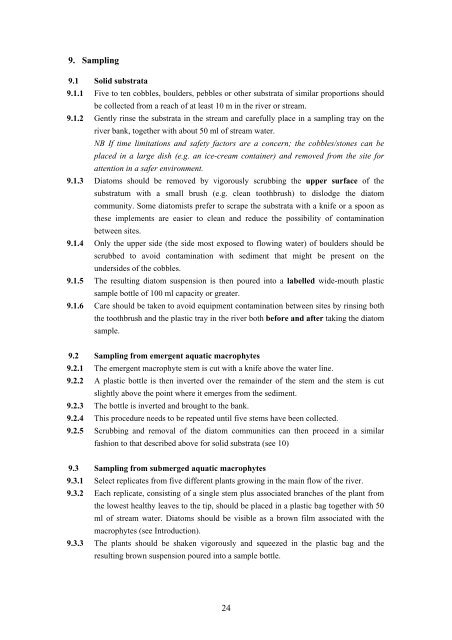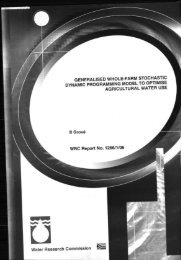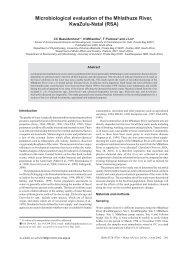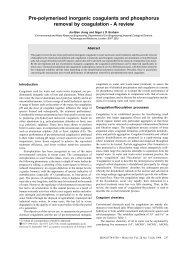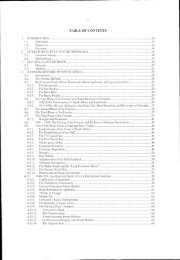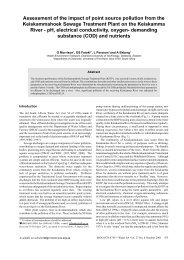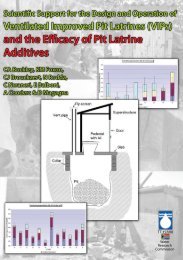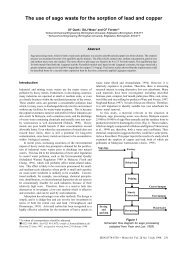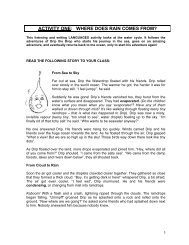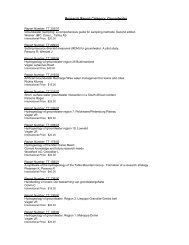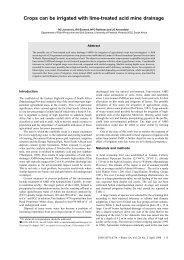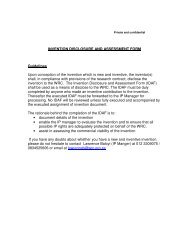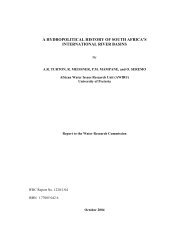A Methods Manual for the Collection, Preparation and Analysis of ...
A Methods Manual for the Collection, Preparation and Analysis of ...
A Methods Manual for the Collection, Preparation and Analysis of ...
You also want an ePaper? Increase the reach of your titles
YUMPU automatically turns print PDFs into web optimized ePapers that Google loves.
9. Sampling9.1 Solid substrata9.1.1 Five to ten cobbles, boulders, pebbles or o<strong>the</strong>r substrata <strong>of</strong> similar proportions shouldbe collected from a reach <strong>of</strong> at least 10 m in <strong>the</strong> river or stream.9.1.2 Gently rinse <strong>the</strong> substrata in <strong>the</strong> stream <strong>and</strong> carefully place in a sampling tray on <strong>the</strong>river bank, toge<strong>the</strong>r with about 50 ml <strong>of</strong> stream water.NB If time limitations <strong>and</strong> safety factors are a concern; <strong>the</strong> cobbles/stones can beplaced in a large dish (e.g. an ice-cream container) <strong>and</strong> removed from <strong>the</strong> site <strong>for</strong>attention in a safer environment.9.1.3 Diatoms should be removed by vigorously scrubbing <strong>the</strong> upper surface <strong>of</strong> <strong>the</strong>substratum with a small brush (e.g. clean toothbrush) to dislodge <strong>the</strong> diatomcommunity. Some diatomists prefer to scrape <strong>the</strong> substrata with a knife or a spoon as<strong>the</strong>se implements are easier to clean <strong>and</strong> reduce <strong>the</strong> possibility <strong>of</strong> contaminationbetween sites.9.1.4 Only <strong>the</strong> upper side (<strong>the</strong> side most exposed to flowing water) <strong>of</strong> boulders should bescrubbed to avoid contamination with sediment that might be present on <strong>the</strong>undersides <strong>of</strong> <strong>the</strong> cobbles.9.1.5 The resulting diatom suspension is <strong>the</strong>n poured into a labelled wide-mouth plasticsample bottle <strong>of</strong> 100 ml capacity or greater.9.1.6 Care should be taken to avoid equipment contamination between sites by rinsing both<strong>the</strong> toothbrush <strong>and</strong> <strong>the</strong> plastic tray in <strong>the</strong> river both be<strong>for</strong>e <strong>and</strong> after taking <strong>the</strong> diatomsample.9.2 Sampling from emergent aquatic macrophytes9.2.1 The emergent macrophyte stem is cut with a knife above <strong>the</strong> water line.9.2.2 A plastic bottle is <strong>the</strong>n inverted over <strong>the</strong> remainder <strong>of</strong> <strong>the</strong> stem <strong>and</strong> <strong>the</strong> stem is cutslightly above <strong>the</strong> point where it emerges from <strong>the</strong> sediment.9.2.3 The bottle is inverted <strong>and</strong> brought to <strong>the</strong> bank.9.2.4 This procedure needs to be repeated until five stems have been collected.9.2.5 Scrubbing <strong>and</strong> removal <strong>of</strong> <strong>the</strong> diatom communities can <strong>the</strong>n proceed in a similarfashion to that described above <strong>for</strong> solid substrata (see 10)9.3 Sampling from submerged aquatic macrophytes9.3.1 Select replicates from five different plants growing in <strong>the</strong> main flow <strong>of</strong> <strong>the</strong> river.9.3.2 Each replicate, consisting <strong>of</strong> a single stem plus associated branches <strong>of</strong> <strong>the</strong> plant from<strong>the</strong> lowest healthy leaves to <strong>the</strong> tip, should be placed in a plastic bag toge<strong>the</strong>r with 50ml <strong>of</strong> stream water. Diatoms should be visible as a brown film associated with <strong>the</strong>macrophytes (see Introduction).9.3.3 The plants should be shaken vigorously <strong>and</strong> squeezed in <strong>the</strong> plastic bag <strong>and</strong> <strong>the</strong>resulting brown suspension poured into a sample bottle.24


